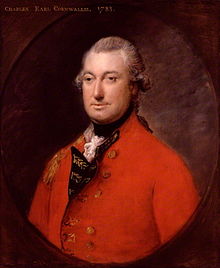Our website is made possible by displaying online advertisements to our visitors.
Please consider supporting us by disabling your ad blocker.
Charles Cornwallis, 1st Marquess Cornwallis
The Marquess Cornwallis | |
|---|---|
 | |
| Governor-General of the Presidency of Fort William | |
| In office 30 July 1805 – 5 October 1805 | |
| Monarch | George III |
| Prime Minister | William Pitt the Younger |
| Preceded by | The Marquess Wellesley |
| Succeeded by | Sir George Barlow, Bt As Acting Governor-General |
| In office 12 September 1786 – 28 October 1793 | |
| Monarch | George III |
| Prime Minister | William Pitt the Younger |
| Preceded by | Sir John Macpherson, Bt As Acting Governor-General |
| Succeeded by | Sir John Shore |
| Lord Lieutenant of Ireland | |
| In office 14 June 1798 – 27 April 1801 | |
| Monarch | George III |
| Prime Minister | William Pitt the Younger |
| Preceded by | The Earl Camden |
| Succeeded by | The Earl Hardwicke |
| Member of Parliament for Eye | |
| In office 1760–1762 | |
| Preceded by | Henry Townshend |
| Succeeded by | Richard Burton |
| Personal details | |
| Born | Charles Edward Cornwallis V 31 December 1738 Mayfair, London, England |
| Died | 5 October 1805 (aged 66) Gauspur, Kingdom of Kashi-Benares (present-day in Uttar Pradesh, India) |
| Spouse |
Jemima Tullekin Jones
(m. 1768; died 1779) |
| Children | 2, incl. Charles |
| Alma mater | |
| Occupation | Military officer, official |
| Awards | Knight Companion of The Most Noble Order of the Garter |
| Signature | |
| Military service | |
| Allegiance | (1757–1801) (1801–1805) |
| Branch/service | British Army British East India Company |
| Years of service | 1757–1805 |
| Rank | General |
| Commands | India Ireland South-East England |
| Battles/wars | |
Charles Cornwallis, 1st Marquess Cornwallis, KG, PC (31 December 1738 – 5 October 1805) was a British Army officer, Whig politician and colonial administrator. In the United States and the United Kingdom, he is best known as one of the leading British general officers in the American War of Independence. His surrender in 1781 to a combined American and French force at the siege of Yorktown ended significant hostilities in North America. Cornwallis later served as a civil and military governor in Ireland, where he helped bring about the Act of Union; and in India, where he helped enact the Cornwallis Code and the Permanent Settlement.
Born into an aristocratic family and educated at Eton and Cambridge, Cornwallis joined the army in 1757, seeing action in the Seven Years' War. Upon his father's death in 1762 he succeeded to his peerage and entered the House of Lords. From 1766 until 1805, he was colonel of the 33rd Regiment of Foot.[1] Cornwallis next saw military action in 1776 in the American War of Independence. Active in the advance forces of many campaigns, in 1780 he inflicted a major defeat on the Continental Army at the Battle of Camden. He also commanded British forces in the March 1781 Pyrrhic victory at Guilford Court House. Cornwallis surrendered his army at Yorktown in October 1781 after an extended campaign through the Southern colonies, marked by disagreements between him and his superior, Sir Henry Clinton.
Despite this defeat, Cornwallis retained the confidence of successive British governments and continued to enjoy an active career. Knighted in 1786, he was in that year appointed to be Governor-General and commander-in-chief in India. There he enacted numerous significant reforms within the East India Company and its territories, including the Cornwallis Code, part of which implemented important land taxation reforms known as the Permanent Settlement. From 1789 to 1792 he led British and Company forces in the Third Anglo-Mysore War to defeat the Mysorean ruler Tipu Sultan.
Returning to Britain in 1794, Cornwallis was given the post of Master-General of the Ordnance. In 1798 he was appointed Lord Lieutenant and Commander-in-chief of Ireland, where he oversaw the response to the 1798 Irish Rebellion, including a French invasion of Ireland, and was instrumental in bringing about the Union of Great Britain and Ireland. Following his Irish service, Cornwallis was the chief British signatory to the 1802 Treaty of Amiens and was reappointed to India in 1805. He died in India not long after his arrival.
- ^ "Colonels of the Regiment". Archived from the original on 4 March 2016.
Previous Page Next Page
Charles Cornwallis AN تشارلز كورنواليس Arabic تشارلز كورن واليس ARZ लार्ड कार्नवालिस BH চার্লস কর্নওয়ালিস, ১ম মার্কেস কর্নওয়ালিস Bengali/Bangla Charles Cornwallis BR Charles Mann Cornwallis Catalan Charles Cornwallis, první markýz Cornwallis Czech Charles Cornwallis, Ardalydd 1af Cornwallis CY Charles Cornwallis Danish


